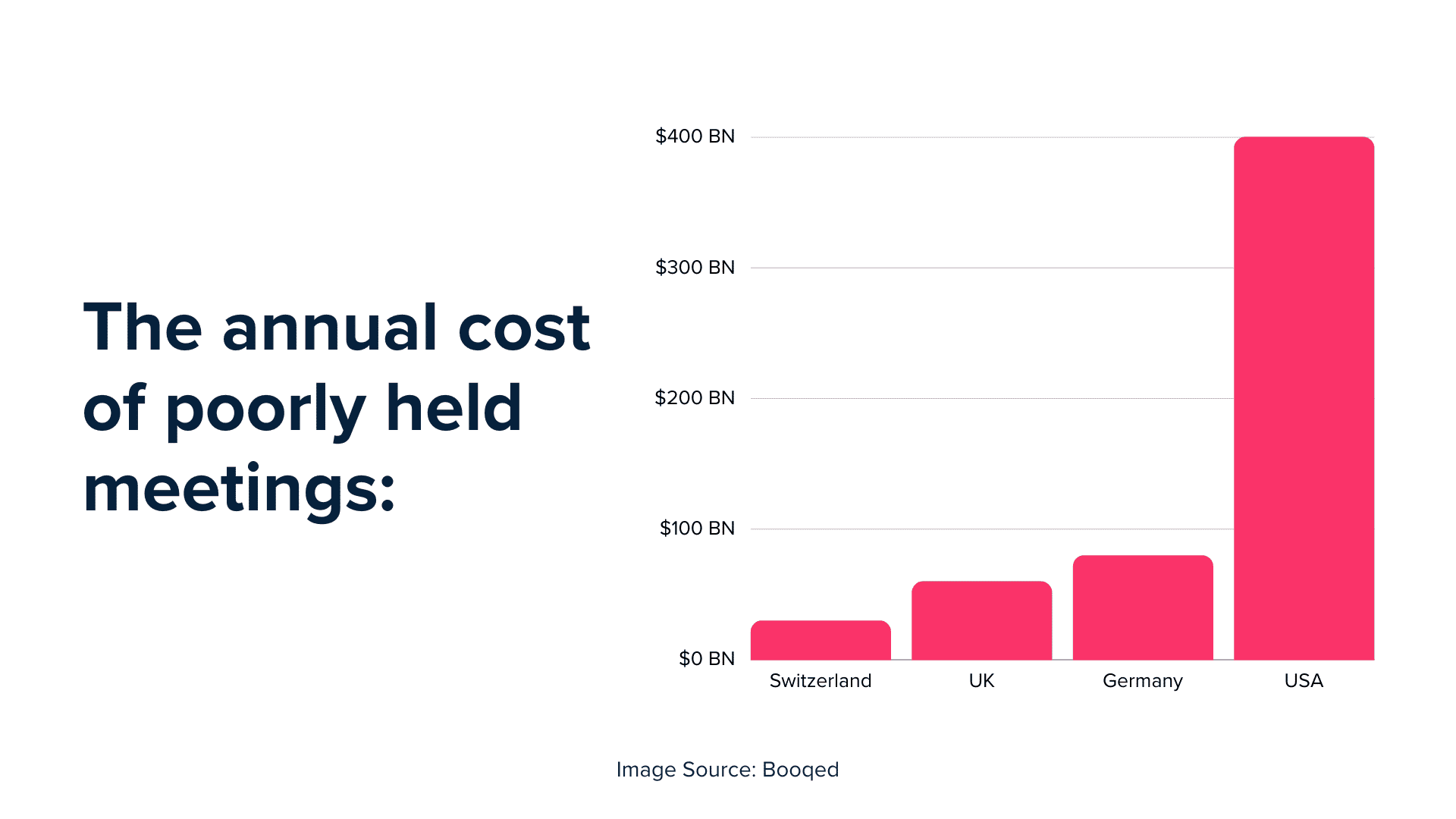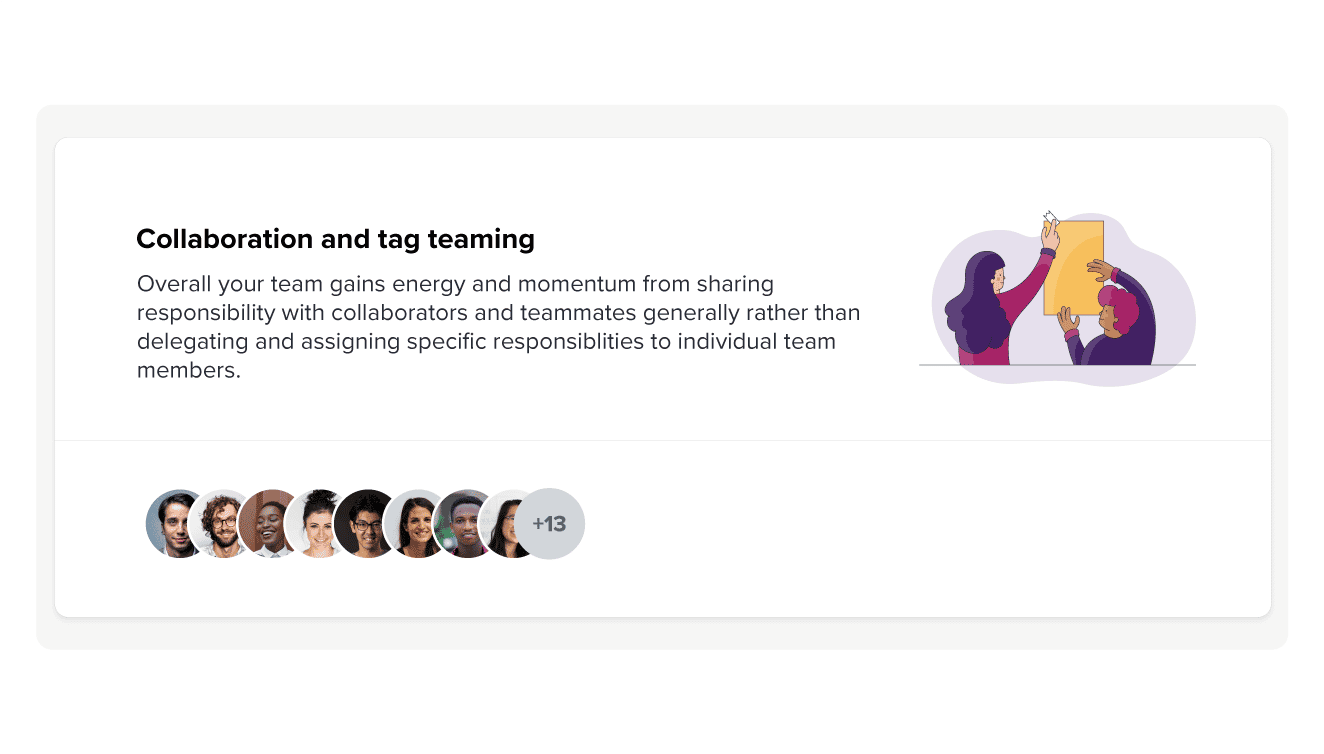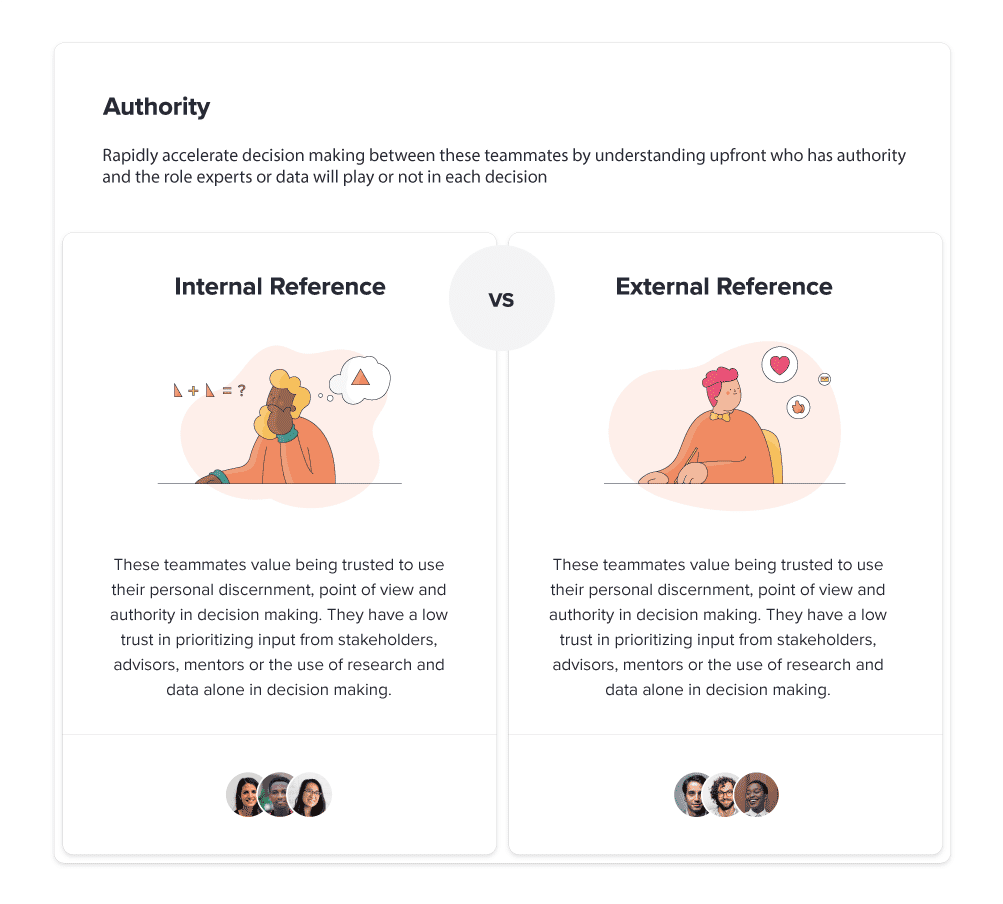Five team meeting agenda examples for high-impact meetings
Imagine you walk into a room and have no real idea why you’re there. You recognize some of the other people there, but not everyone. Someone starts speaking, but you're unsure what they're talking about. Acronyms are tossed around that you're unable to decipher. You do your best to follow along, but it’s hard to stay focused.
Sounds like a bad dream, right?
Actually, meetings like these are common in many organizations. They consume people’s time, but achieve very little simply because they lack a detailed agenda. A team meeting agenda is incredibly important to get people on the same page and keep meetings on track without any unnecessary distractions and sidebar conversations.
In this article, we’ll share how to create high-impact team meeting agendas and provide sample templates you can use to maximize meeting productivity.
Meetings without a clear agenda are costly

- In a company of 5,000 workers, about US$320M is estimated to be spent on meetings annually1
- 60% of workers report attending more meetings now than they did before the pandemic2
- On average, organizations spend $US80,000 per employee per year on meetings1
- Employees typically attend an average of 18 meetings per week1
- 46% of employees agreed with the statement that they have too many unnecessary meetings on their calendars1
- 30% of workers report meetings could have been skipped if the information was shared with relevant parties beforehand1
- 45% of meeting participants have their video and audio turned off during meetings1
- 70% of employees multitask during meetings1
- 91% of employees have daydreamed during meetings3
- Reducing unnecessary meeting attendance can save an average of US$25,000 per employee per year1
What should a team meeting agenda include?
When organizing a productive meeting, it's crucial to have a clear and simple agenda. It should outline the context, key attendees, meeting goals, and topics to be discussed. By establishing these elements, the entire team can come prepared and know what to expect. This is especially important for remote meetings, as they can present unique challenges.
A clear meeting agenda is also essential in order for attendees to agree on the next steps and assign responsibilities before closing the meeting, whether for large meetings or one-on-ones. Afterward, the meeting organizer should circulate meeting notes and action items. This ensures everyone is on the same page and knows exactly what’s expected. If holding a virtual meeting, it is especially important to share meeting notes – electronically, of course.
Additionally, it pays to consider the meeting duration – aim to make it as short as possible but don’t discount the value of collaboration completely – run well, meetings can be productive sessions that solve problems, motivate teams and fast-track progress.
Lastly, it's essential to consider who really needs to attend and whether the use of asynchronous meetings using tools such as Slack are appropriate. Circulating the agenda beforehand will confirm its relevance to all attendees and provide people the opportunity to suggest items to include. Teamwork makes the dream work, after all!
Five examples of meeting agendas
So you've decided a meeting is necessary for communication or collaboration purposes. Next, decide on the best agenda format. You might use the daily standup method or convene for functional team meetings in a conventional sit-down format. A well-crafted meeting agenda is crucial regardless of the meeting type or format. It ensures everyone knows what to expect and what will be covered.
Below, we'll explore five team meeting agenda formats and examples of what the agenda should look like for each so you don't have to create it from scratch.
1. Formal meeting agenda
A formal meeting agenda is a structured and organized document. It outlines the discussion topics in order and the time allocated for each item. This formal agenda helps everyone understand what will be discussed and the outcomes that are expected.
A typical formal meeting agenda should include the following elements:
- Opening and introductions
- Review of previous meeting minutes
- Agenda review and approval
- Discussion of agenda items
- Action items and next steps
- Closing and adjournment
This format is particularly beneficial for:
- Board meetings
- Project status meetings
- Performance reviews
- Leadership meetings
Formal Meeting Agenda Template
2. Effective meeting agenda
An effective meeting agenda is a document focused on achieving the objectives of the meeting in a timely and productive manner. It provides a clear structure for the meeting and ensures all relevant topics are covered.
An effective agenda should include the following elements:
- Purpose: Clearly state the purpose of the meeting and what you hope to achieve
- Attendees: List the names of all attendees and their roles
- List of topics: Identify the specific meeting topics that will be covered
- Time: Indicate the amount of time allocated to each topic
- Action items: Identify the specific action items assigned due to the meeting
This format is particularly beneficial for:
- Agile software development teams
- Marketing departments
- Executive team meetings
- Project management teams
Effective Meeting Agenda Template
3. Sample meeting agenda
A sample meeting agenda is a document that outlines the topics to be discussed and the order in which they will be addressed in a meeting. It's a helpful tool to make sure all crucial subjects are covered, and the meeting stays on schedule. A sample meeting agenda is flexible and can be adapted to fit the specific needs of any organization or project.
A typical sample meeting agenda may include the following elements:
- Meeting information: The date, meeting time, and meeting location
- Introductions: The name and role of each participant
- Approval of previous meeting minutes: Review and approve the event meeting notes from the last meeting
- Action items review: Review the progress of agenda action items from the previous meeting
- New business: Discuss new topics and major updates that need to be addressed
- Old business. Discuss topics and issues that were not resolved in the previous meeting
- Roundtable: Allow each participant the chance to provide input or ask questions on any topic
- Next meeting: Set a date, time, and location for the next meeting
- Adjournment: Officially end the meeting
This format is particularly beneficial for:
- Leadership team meetings to share company updates
- Staff meetings for small businesses or nonprofit organizations
- Committee meetings
- Board of directors meeting
- City council meeting
Sample Meeting Agenda Template
4. All-hands team meeting agenda
An all-hands meeting is a company-wide meeting held periodically – once a quarter or once a year, for example. It provides updates, announcements, feedback, and discussions for the entire organization. The all-hands meeting promotes transparency, alignment, and engagement throughout the organization.
A typical all-hands meeting agenda should include the following elements:
- Opening and introductions: Start the meeting by welcoming everyone and introducing any new members of the team
- Company updates: Provide updates on the company's current situation, achievements, challenges, and future plans. This could include new product launches, company structure changes, or company-wide activities
- Q&A session: Allow time for employees to ask check-in questions and provide feedback on any issues or concerns they may have
- Team presentations: Invite speakers from other departments to provide business updates. Marketing strategy and competitor strategy can be shared with the team
- Closing remarks: End the meeting with a summary of the key takeaways, actionable items, and next steps
This format is particularly beneficial for:
- Project kick-off meeting
- Sales meetings
- Company announcements
- Project updates
All-hands Team Meeting Agenda
5. Asynchronous meeting agenda
An asynchronous meeting agenda is designed for teams working remotely or across different time zones. This type of agenda allows participants to contribute to the meeting at their convenience rather than all at once. It allows participants in remote teams to contribute at their own pace and can be an effective way to make decisions and move projects forward.
The following is a breakdown of what an asynchronous meeting agenda should look like:
- Introduction and overview: Start with an introduction and overview of the meeting's purpose and goals
- Agenda items: Create a simple list of discussion items that must be addressed in the meeting. Include a brief description of each item to provide context
- Discussion threads: Create discussion threads for each agenda item. Participants can share updates, thoughts, feedback, and ideas asynchronously. Each thread should have a clear topic and purpose
- Action items: Include a section for action items and the next steps. Assign tasks to specific team members and set deadlines for completion
- Conclusion: End the meeting with a brief summary of the key points discussed and the next steps
This format is particularly beneficial for:
- Marketing team meetings
- Weekly team meetings
- Remote leadership teams
- Casual discussions
Asynchronous Meeting Agenda Template
For global organizations, you can adapt team meeting agendas to suit each region
Conducting meetings with team members from different regions requires cultural awareness to optimize team dynamics. It's important to keep in mind that each culture has different work styles and approaches to meetings.
In some cultures, building a personal relationship before discussing business is important. While in others, time is seen as a precious commodity, and meetings need to be brief and to the point. It’s also important to have an understanding of the team culture, generally, in order to lead and communicate effectively with each team member.
For organizations, F4S's Culture Map delivers a groundbreaking and insightful analysis of your team's unique culture. We conduct a statistical deep dive into each of your employee’s and team’s work styles and motivations, providing you with a detailed analysis of what drives behavior.
.png)
For leaders with a team based in different countries, once you’ve taken the F4S assessment and set up your team in the F4S platform, the Team Culture report can help you identify the cultural differences in each region, so you can tailor meeting agendas to the specific needs of each regional team.
The Affinities report will show you attitudes that your team has in common.

The Differences report will show you attitudes where your team differs.

Accelerate understanding between teams
Breadth

Motivated by macro big picture thinking, these teammates value moving quickly to connect dots between abstract ideas to 'get the gist' of things.

vs
Depth

These teammates value being concrete and specific, getting into details to understand the steps or tasks required.

See the different work styles in your team
Take the free assessment & set up your teamThis way, you can ensure everyone feels comfortable and engaged during the meeting and you aren’t unwittingly causing offense or confusion. This leads to better communication, collaboration, and more successful outcomes.
To get started, take the free assessment. Then create a team and invite your teammates to take the assessment. You'll gain instant access to your team dynamics.
-min.gif)
Increase remote engagement with the F4S Zoom integration
Your team is unique and so are their communication peferences. To have the most effective Zoom meeting, download the F4S app in Zoom.
At a glance you'll see helpful tips on the best way to communicate with attendees. Other F4S users will have emojis on their zoom background related to whether they prefer hearing, reading, seeing, or doing.
A quick note on action items
Action items are important in any high-impact meeting because they make sure the goals of the meeting have actually been achieved. Actionable conversations involve participants sharing their ideas and opinions, and actively seeking resolutions.
Action items also help ensure follow-up and accountability, which is critical for success in any meeting.
Before calling a meeting, consider whether the issue truly requires one. If it does, proper preparation should be taken.
- Only call a meeting if it absolutely needs to be called
- When you call it, attach relevant documents to the invite and explain to everyone what the meeting is and who is invited and why
- At the meeting, listen to the flow of ideas and discussion
- Course-correct if necessary but be tactful in how you do it
- Hard-stop the dialogue 10 minutes before the meeting end time
- Recap for 2-3 minutes
- Propose 3-4 next steps
- Get agreement on those next steps
- Assign the work to team members to action
- Include follow-through due dates in next steps
- Break the meeting within the agreed timeframe
“That meeting could have been an email”
That’s a popular meme about wasteful meetings. But is it true? In some cases, yes, but most often, no. Organizational psychologist and management professor Dr David Burkus argues that a lot of what happens in meetings can’t be replaced with a digital memo.5
“A long-standing maxim on communication has it that only 7% of information communicated in person is verbal – the actual words of that could be conveyed in an email,” Dr Burkus explains. “The remaining 93% are contextual elements such as non-verbal cues, tone of voice, context, and feedback.”6
Resilient Management author Lara Hogan, has a similar viewpoint:
“Sensitive, difficult, or surprise information – such as the context for a big roadmap upheaval, a staffing change, or anything else that involves managing emotions – is best communicated in person first (and followed up with an email),” says Hogan. “This way, you can pivot your message based on the questions or reactions in the room, and you can add extra color with your words, your body language, and your tone of voice.”
So yes, sometimes meetings do need to happen. And you need a team meeting agenda when they do.
The core tenets of an effective team meeting agenda
These are:
- Make the meeting objective clear: Why is this a meeting? What is the end goal? Why are these specific people on Zoom or in the room together?
- Agenda topics should be questions or tasks: In this way, people know what to think about or what the resultant taskwork might be. If you are providing a status update, be sure to keep it brief
- Clarify expectations and responsibilities. Send out the team meeting agenda before the meeting itself. And if you put team member names in parentheses near their items, people can begin to understand their specific role in the meeting
- Estimate realistic amounts of time for each section: Keep it within the timeframe everyone accepted, but don’t skirt around important parts, such as action items or the beginning/icebreaker period. “Getting down to business” is great, but people also need room to breathe at both ends of a meeting
- Design slots for feedback and recognition: Keep the work human if you want your team to stay motivated
- Use the right tools: Don't forget there are many AI tools for meetings that ensure every detail is recorded.
A brief note on types of team meeting agendas
Here we don’t mean ‘scrum’ vs. ‘stand-up’ vs. any other model. Instead, what we mean is that meetings serve different purposes. For example, meetings can be:
- Information-driven: “You need to know this stuff to succeed”
- Action-driven: “We are going to do work and achieve an output in this session”
- Discussion-driven: “We are going to talk through issues and figure out the basics of a plan”
Some meetings may contain elements of all three of these at once:
- Training: Meetings where people learn new skills or processes
- Personal development: These are often one-on-one meetings or daily status meetings, but some meetings take the format of developing an employee
Team meeting agenda bottom line
No one wants to spend a big chunk of their week in worthless, unproductive meetings. A meeting agenda focused on why people are together, what needs to be done, and how to do it helps make meetings matter.
One of the core goals of Fingerprint for Success is building strong teams through effective communication and leadership – all skills you can acquire via the F4S personalized coaching platform. Run well, meetings can be valuable in applying what you’ve learned.
Have high-impact meetings that motivate your team
Take the free F4S assessment now to find out your motivational strengths and blind spots. Then invite your team to take the assessment to learn what gives you and your team energy and fulfillment at work, and how to improve team performance.
My coaching Plan:
Our expert coaches have designed hyper-effective programs that will help
you learn to have high-impact meetings that motivate your team in 15-minutes a week.
Coach Marlee (your amazing AI-powered personal coach) will analyse your unique traits and goals to let you know which program to start with (and if there are any you should skip)!
Your recommended programs include:
My Coaching Plan:
Our expert coaches have designed hyper-effective programs that will help you improve your mental health, wellbeing, productivity, leadership and more.
Coach Marlee (your amazing AI-powered personal coach) will analyse your unique traits and goals to let you know which program to start with (and if there are any you should skip)!
Your recommended programs include:

Team Building
Take your teaming to the next level in this high impact 9-week team coaching program with Coach Marlee. Discover and optimize complementary strengths and unique talents with your team, reach decisions together quickly, enjoy team cohesion, high energy and motivation as a bonded team.

Attention to Detail
Impress yourself and others with your attention to detail! Develop a genuine appreciation, energy and stamina for detailed thinking to execute your vision, measure performance in yourself and others while also accelerating your ability to learn and change.

Personal Power
In this high impact eight week program Coach Marlee will help you increase your comfort and confidence to be in positions of influence and leadership, navigate organizational politics and also help you develop greater confidence to compete and influence at the top of your industry or field.

Multiply Your Impact
Multiply your impact by embracing the experience and genius within others. During this eight week program Coach Marlee will help you to develop a genuine appreciation for experimentation and data and a willingness to empower the opinions, feedback and insights within your team and others in your life.

Trust Your Gut Feel
Explore, strengthen and stand by what you believe in at work and in life. Trust in your ‘gut feel’ and point of view is especially helpful for influencing, starting your own business, having your personal needs met and for living an authentic and meaningful life.

Big Picture Thinker
Inspire yourself and others to see the bigger picture! Increase your comfort and use of abstract and strategic thinking to gain a broader perspective in work and life. Big picture thinking is key in communication, leadership, businesses, selling, marketing, and situations where you need to get the gist of things quickly.

Reflection & Patience
Develop ‘step back’ mastery for increased self-awareness and developing mindsets and tools for constant improvement. Reflection and patience is core to consolidating learning, development, strategic thinking, recharging and living an authentic and meaningful life.

Start Fast
Close the gap between your great ideas and starting them. Energy and drive for starting is key for inventing new things, starting businesses, selling, marketing, socializing or in situations where you need to think on your feet.

Increase EQ
Explore, develop or strengthen your emotional intelligence (EQ). Awareness of your and others’ emotions is at the heart of influencing, ‘reading people’, impactful communication, deep relating and authentic connection at work and in life.

Goal Catcher
Inspire yourself and others to see and achieve grand visions and goals. A focus on goals is especially helpful for inspirational leaders, starting your own business, impactful communication, or for achieving awesome outcomes at work and in life.
Testimonials

“What an awesome way to get better at collaborating with my teammates! Thumbs up Marlee!“

"I have learned how to communicate better using every tool I have in myself, especially in learning how to use my tone of voice"

“This was a good reflection and trigger to make the decision that I was pondering!”

“Quite amazing how many things get done when they are initiated!”

"I have learned how to communicate better using every tool I have in myself, especially in learning how to use my tone of voice"

“Marlee helped me to work on my self-belief”

“Mind blowing! The Team Building program helped us resolve long-standing friction and misunderstandings in the team. Great experience for everyone involved!“

“Blew my mind, had no idea how arrogant I have been. Total blind spot. I really like the multiplier stuff”
- The Cost of Unnecessary Meeting Attendance. Available at: https://20067454.fs1.hubspotusercontent-na1.net/hubfs/20067454/Report_The%20Cost%20of%20Unnecessary%20Meeting%20Attendance.pdf
- Unproductive Meetings Under the Microscope: Statistics That Demand Attention. Available at: https://www.runn.io/blog/unproductive-meetings-statistics#:~:text=But%20according%20to%20a%20study,hours%20per%20week%20in%202021
- All-Hands Meetings: The Complete Guide to Leading Effective All-hands Meetings. Available at: https://www.charma.com/resources/all-hands-meetings
- 6 Sample Meeting Agenda Examples. Available at: https://www.hugo.team/blog/sample-meeting-agenda-examples
- How to Run an Effective Weekly Team Meeting. Available at: https://fellow.app/blog/2019/weekly-team-meeting-agenda-templates/
- Booqed. Available at: https://www.booqed.com/blog/minutes-wasted-of-meeting-50-shocking-meeting-statistics
- No, That Meeting Could Not Have Been an Email. Available at: https://hbr.org/2015/04/no-that-meeting-could-not-have-been-an-email
Related Articles
What’s your communication style?
Learn how to connect with colleagues and boost workplace motivation.

Name Surname
Position, Company name

Name Surname
Position, Company name

Name Surname
Position, Company name

Name Surname
Position, Company name

Name Surname
Position, Company name

Name Surname
Position, Company name
Your submission has been received!

Hack your wellbeing, productivity and goals
Programs are created by expert coaches & delivered by our incredible A.I. Coach Marlee. Sessions only take 5-15 minutes and are 100% personalized to fit your unique traits and goals.
